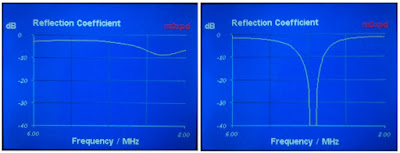The little bridge you saw back in September is now producing - in concert with the AD 7896 analog to digital converter and a few other little wrangles - some nice, calibrated measures of reflection coefficient (and, in other programs, other metrics - but I'm only going to show Reflection Coefficient here).
Impedances under test are connected to the bridge at the point labelled "test port" in the photo above.
To start with - rather in the way of the limbering up exercise that athletes do before they make any real effort - here's a measurement of the limiting cases of open- and short-circuit conditions...
Apologies for the poor photos - it isn't easy to photograph the little 2.4 inch TFT screen. In these limiting cases, the signal returned from the "perfectly UN-matched" termination is exactly equal to the signal applied; there is no return loss. The reflection coefficient (which is the negative of the return loss) is also zero. You see this zero result from 6 to 8 MHz in the plots above.
Next, the rather more interesting cases of a 100 Ohm resistor and the (perfectly matched) 50 Ohm case...
The theoretical reflection coefficient from a 100R resistor is -9.55dB, so you see the measurement is doing a pretty good job. The perfectly matched 50R resistor should give no reflection and a -inf reflection coefficient. I arranged for my graphing routine to clip everything to -40dB to neaten up the bottom of the (finite) dynamic range of my system (-40dB reflection corresponds to a VSWR of 1.02, so this is an entirely adequate dynamic range).
So much for "validating" measurements - what about real applications?
Here is a measurement of the reflection coefficient from the feeder to my antenna system at the shack, over the same frequency range, both direct and then tuned...
The system un-tuned (left) offers VSWR above 2. However, when seen through my "Made from Junk" MFJ-969, the antenna offers a well matched load in the CW portion of the 40m band - just as my settings of the tuner asked it to!
This is now a working "measurement" system - if measurement isn't too grand a word. It involves a few neat tricks, which are going to be published in magazine / journal articles, so watch out for those in the usual places over the coming six months or so. There will be more to say in these pages on related issues as well.
Amazin' what you can do with a DDS and a diode!
...-.- de m0xpd
Subscribe to:
Post Comments (Atom)





No comments:
Post a Comment